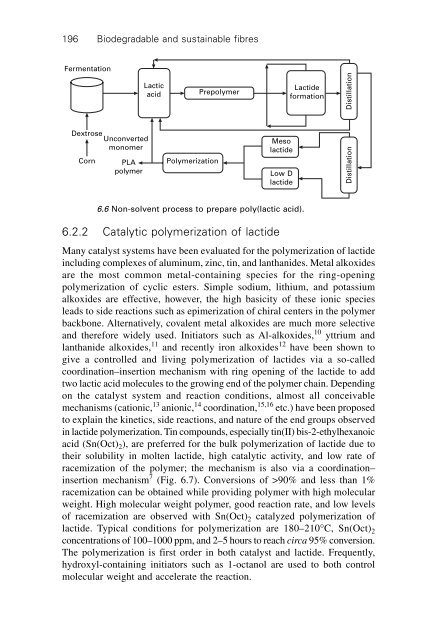Poly(lactic acid) fibers - Jim Lunt LLC
Poly(lactic acid) fibers - Jim Lunt LLC
Poly(lactic acid) fibers - Jim Lunt LLC
- No tags were found...
You also want an ePaper? Increase the reach of your titles
YUMPU automatically turns print PDFs into web optimized ePapers that Google loves.
196Biodegradable and sustainable fibresFermentationLactic<strong>acid</strong>PrepolymerLactideformationDistillationDextroseCornUnconvertedmonomerPLApolymer<strong>Poly</strong>merizationMesolactideLow DlactideDistillation6.6 Non-solvent process to prepare poly(<strong>lactic</strong> <strong>acid</strong>).6.2.2 Catalytic polymerization of lactideMany catalyst systems have been evaluated for the polymerization of lactideincluding complexes of aluminum, zinc, tin, and lanthanides. Metal alkoxidesare the most common metal-containing species for the ring-openingpolymerization of cyclic esters. Simple sodium, lithium, and potassiumalkoxides are effective, however, the high basicity of these ionic speciesleads to side reactions such as epimerization of chiral centers in the polymerbackbone. Alternatively, covalent metal alkoxides are much more selectiveand therefore widely used. Initiators such as Al-alkoxides, 10 yttrium andlanthanide alkoxides, 11 and recently iron alkoxides 12 have been shown togive a controlled and living polymerization of lactides via a so-calledcoordination–insertion mechanism with ring opening of the lactide to addtwo <strong>lactic</strong> <strong>acid</strong> molecules to the growing end of the polymer chain. Dependingon the catalyst system and reaction conditions, almost all conceivablemechanisms (cationic, 13 anionic, 14 coordination, 15,16 etc.) have been proposedto explain the kinetics, side reactions, and nature of the end groups observedin lactide polymerization. Tin compounds, especially tin(II) bis-2-ethylhexanoic<strong>acid</strong> (Sn(Oct) 2 ), are preferred for the bulk polymerization of lactide due totheir solubility in molten lactide, high catalytic activity, and low rate ofracemization of the polymer; the mechanism is also via a coordination–insertion mechanism 7 (Fig. 6.7). Conversions of >90% and less than 1%racemization can be obtained while providing polymer with high molecularweight. High molecular weight polymer, good reaction rate, and low levelsof racemization are observed with Sn(Oct) 2 catalyzed polymerization oflactide. Typical conditions for polymerization are 180–210∞C, Sn(Oct) 2concentrations of 100–1000 ppm, and 2–5 hours to reach circa 95% conversion.The polymerization is first order in both catalyst and lactide. Frequently,hydroxyl-containing initiators such as 1-octanol are used to both controlmolecular weight and accelerate the reaction.


